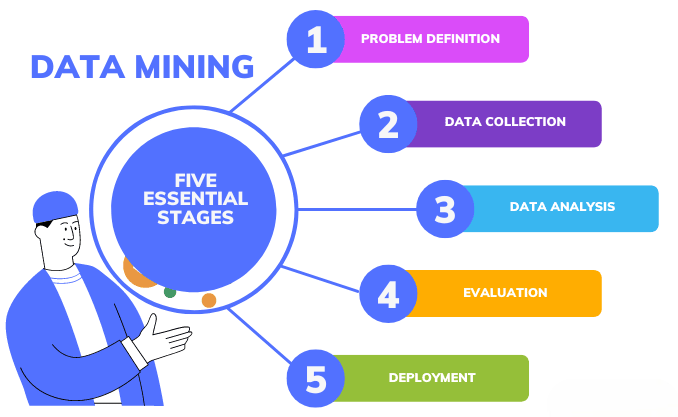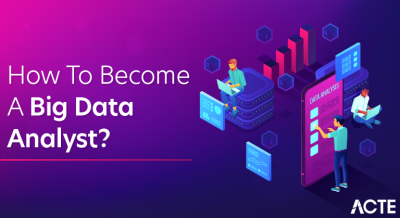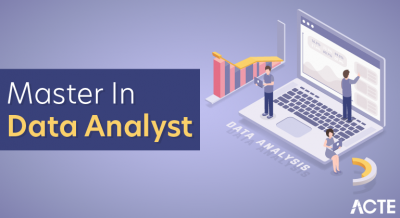
- Introduction to Data Mining
- Data Mining in Healthcare
- Data Mining in Finance
- Data Mining in Retail
- Data Mining in Education
- Data Mining in Manufacturing
- Data Mining for Fraud Detection
- Conclusion
Introduction to Data Mining
Data mining is the process of extracting meaningful patterns, correlations, and insights from large volumes of data using techniques from statistics, machine learning, and database systems. It enables organizations to turn raw data into valuable information that can drive strategic decision-making, uncover hidden trends, and optimize business processes. In today’s digital age, where data is generated at an unprecedented rate, data mining has become a fundamental part of business intelligence and advanced analytics. The data mining process typically follows several key stages. It begins with data collection, where relevant data is gathered from various sources such as databases, sensors, or user activity logs, which is a fundamental step in Data Science Training. Next, data cleaning is performed to handle missing values, remove duplicates, and correct inconsistencies, ensuring high data quality. This is followed by data exploration, where statistical summaries and visualizations help understand the data and guide model selection. In the modeling phase, machine learning algorithms such as classification, clustering, or regression are applied to identify patterns or predict outcomes. Finally, the results are interpreted and used to support business decisions, marketing strategies, customer segmentation, risk management, and more. Overall, data mining empowers organizations to harness the full potential of their data, gain a competitive edge, and adapt to a rapidly changing market landscape.
Are You Interested in Learning More About Data Science? Sign Up For Our Data Science Course Training Today!
Data Mining in Healthcare
Healthcare is one of the industries that benefits significantly from data mining, as it generates and stores massive volumes of patient-related data daily. Hospitals, clinics, and research institutions collect data from electronic health records (EHRs), lab results, imaging systems, and wearable devices. Through data mining techniques, this wealth of information can be transformed into actionable insights that improve patient care, enhance operational efficiency, and support medical research, often utilizing Top Python Libraries For Data Science One of the most impactful uses of data mining in healthcare is predictive modeling. Techniques such as classification, regression, and clustering are used to forecast disease outbreaks, predict patient readmission risks, and identify early warning signs of chronic illnesses. This allows healthcare providers to intervene early and deliver personalized treatment plans tailored to each patient’s medical history and risk profile.

Data mining also plays a key role in medical imaging by enhancing image analysis for faster and more accurate diagnoses. In genomics and drug discovery, it helps identify genetic markers and potential therapeutic compounds by analyzing large biological datasets. Moreover, anomaly detection can uncover irregularities in patient data, such as unusual test results, which may signal potential health threats. Overall, data mining drives the shift toward data-driven, predictive, and personalized healthcare, ultimately leading to better outcomes and reduced costs.
Data Mining in Finance
- Customer Segmentation: Clustering techniques group customers based on spending habits and financial behavior, allowing for personalized marketing and product recommendations.
- Portfolio Management: Data mining supports investment decision-making by identifying asset correlations, predicting stock movements, and optimizing portfolio allocations.
- Loan Approval Automation: Classification models streamline the loan approval process by predicting default risk and identifying eligible applicants efficiently.
- Financial Forecasting: Regression and time series analysis help forecast market trends, interest rates, and economic indicators, supporting strategic planning laying the groundwork to understand advanced concepts like What is Logistic Regression.
- Fraud Detection: Data mining techniques like anomaly detection and classification help identify unusual transaction patterns that may indicate fraud. Real-time systems can flag suspicious activity for immediate investigation.
- Credit Scoring and Risk Assessment: Financial institutions use data mining to evaluate a borrower’s creditworthiness. Predictive models analyze past financial behavior, enabling accurate risk assessment.
- Algorithmic Trading: Data mining is used to discover patterns in historical market data, helping to develop algorithms that make automated trading decisions based on trends and signals.
- Customer Segmentation: Data mining clusters customers based on purchasing habits, demographics, and preferences, enabling personalized marketing and targeted promotions.
- Market Basket Analysis: By analyzing items frequently bought together, retailers can optimize product placement, design bundles, and boost cross-selling opportunities.
- Inventory Management: Data mining predicts demand trends and seasonal variations, helping retailers maintain optimal stock levels and reduce holding costs, which is a key application taught in Data Science Training.
- Sales Forecasting: Regression models analyze historical sales data to forecast future sales, guiding budgeting and strategic planning.
- Customer Churn Prediction: Identifying customers likely to stop buying allows retailers to develop retention strategies and improve loyalty programs.
- Pricing Optimization: Data mining helps understand price sensitivity and competitor pricing, enabling dynamic pricing strategies that maximize profit and market share.
- Fraud Detection: Detecting unusual transactions or returns protects retailers from fraudulent activities and financial losses.
- Predictive Maintenance: Data mining analyzes sensor data from machines to predict equipment failures before they happen, reducing downtime and maintenance costs.
- Quality Control: By identifying patterns in production data, manufacturers can detect defects early and improve product quality.
- Supply Chain Optimization: Data mining helps analyze supply chain data to forecast demand, manage inventory, and optimize logistics.
- Process Optimization: Analyzing manufacturing processes uncovers inefficiencies, enabling improvements that reduce waste and increase throughput, a task that can be efficiently handled using Python Generators for processing large datasets.
- Demand Forecasting: Using historical sales and market data, data mining predicts future product demand to better align production schedules.
- Energy Management: Monitoring energy consumption patterns allows manufacturers to reduce costs and improve sustainability.
- Safety Monitoring: Data mining identifies risk factors in the workplace by analyzing accident reports and sensor data, promoting a safer environment.
To Explore Data Science in Depth, Check Out Our Comprehensive Data Science Course Training To Gain Insights From Our Experts!
Data Mining in Retail

Data Mining in Education
Data mining in education, often referred to as Educational Data Mining (EDM), is transforming how institutions understand and enhance the learning experience. By analyzing vast amounts of data generated through learning management systems, student performance records, and online interactions, educational institutions can gain deep insights into student behavior, academic progress, and learning outcomes. One of the primary applications of data mining in education is student performance prediction. By identifying patterns in attendance, assignment submissions, and test scores, institutions can detect at risk students early and provide timely support an analysis often conducted using tools compared in Python vs R vs SAS. Personalized learning paths are another key benefit, where algorithms tailor content and pacing to individual student needs, improving engagement and academic success. Data mining also helps in curriculum improvement by analyzing which courses or modules are most effective and where students typically struggle. Instructors can adjust teaching strategies based on these insights. Additionally, dropout prediction models help educators intervene before a student leaves the system, improving retention rates. Moreover, administrative decision-making is enhanced by data-driven insights into resource allocation, course scheduling, and overall institutional performance. As education becomes increasingly digital, data mining serves as a powerful tool to foster smarter, more responsive, and more effective educational environments.
Are You Considering Pursuing a Master’s Degree in Data Science? Enroll in the Data Science Masters Course Today!
Data Mining in Manufacturing
Data Mining for Fraud Detection
Fraud detection is a vital application of data mining, playing a key role in sectors such as finance, insurance, healthcare, and e-commerce. As fraudulent schemes become increasingly complex and sophisticated, organizations rely on data mining techniques to uncover hidden patterns and detect anomalies within massive datasets. These patterns often represent irregular behavior that signals potential fraud. Data mining methods like anomaly detection, clustering, and classification are commonly used to identify suspicious activities. Anomaly detection highlights unusual transactions that deviate from normal behavior, while clustering groups similar data points to expose outliers demonstrating Why Data Science Matters & How It Powers Business Value. Classification models, trained on historical data, can categorize transactions as legitimate or fraudulent, enhancing the accuracy of fraud detection systems. Real-time fraud detection systems powered by data mining continuously monitor transactions and trigger alerts for any suspicious behavior, allowing for immediate intervention. These systems are particularly effective in credit card transactions, insurance claims, and online purchases. Moreover, the integration of machine learning enables these models to evolve by learning from new fraud patterns over time. This adaptability makes data mining an indispensable tool in the fight against fraud, helping organizations reduce losses, maintain trust, and stay ahead of evolving threats in a data-driven world.
Are You Preparing for Data Science Jobs? Check Out ACTE’s Data Science Interview Questions & Answer to Boost Your Preparation!
Conclusion
In conclusion, data mining stands at the core of modern decision-making, innovation, and strategic growth. By uncovering hidden patterns, correlations, and trends within large datasets, data mining empowers organizations to make smarter, faster, and more informed decisions. Its role is critical across a wide range of industries enabling early disease detection in healthcare, fraud prevention in finance, personalized marketing in retail, and improved learning outcomes in education. As the volume of data continues to grow exponentially, the need to extract meaningful insights becomes increasingly urgent. Data mining techniques such as classification, clustering, association rule mining, and anomaly detection offer the tools necessary to turn raw data into valuable knowledge, and are essential components of Data Science Training. These insights help organizations enhance efficiency, reduce costs, improve customer experiences, and gain a competitive edge. Looking ahead, data mining will only become more vital as emerging technologies like artificial intelligence, machine learning, and big data analytics continue to evolve. Mastery of data mining tools and methodologies will be a crucial skill set for data professionals, decision-makers, and anyone involved in data-driven roles. Ultimately, data mining is not just about analyzing data it’s about unlocking its full potential to drive meaningful outcomes and sustainable success in an increasingly data-centric world.





